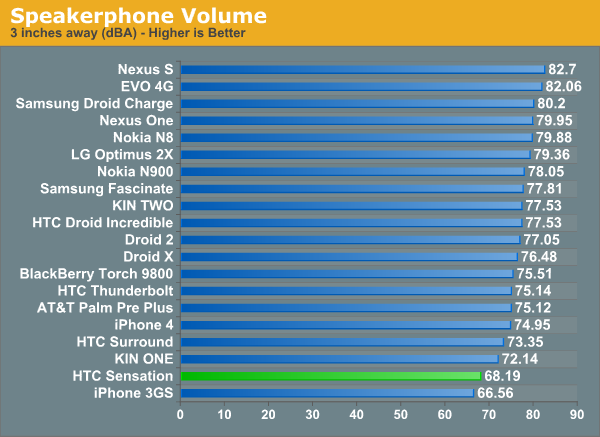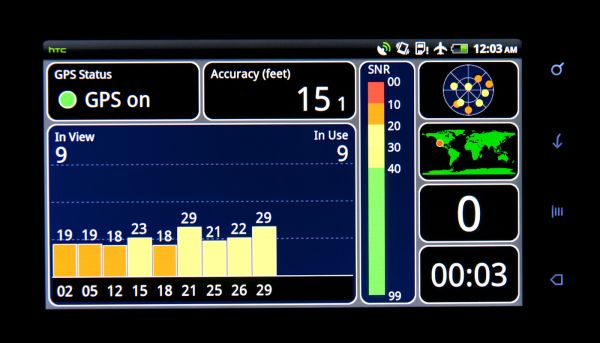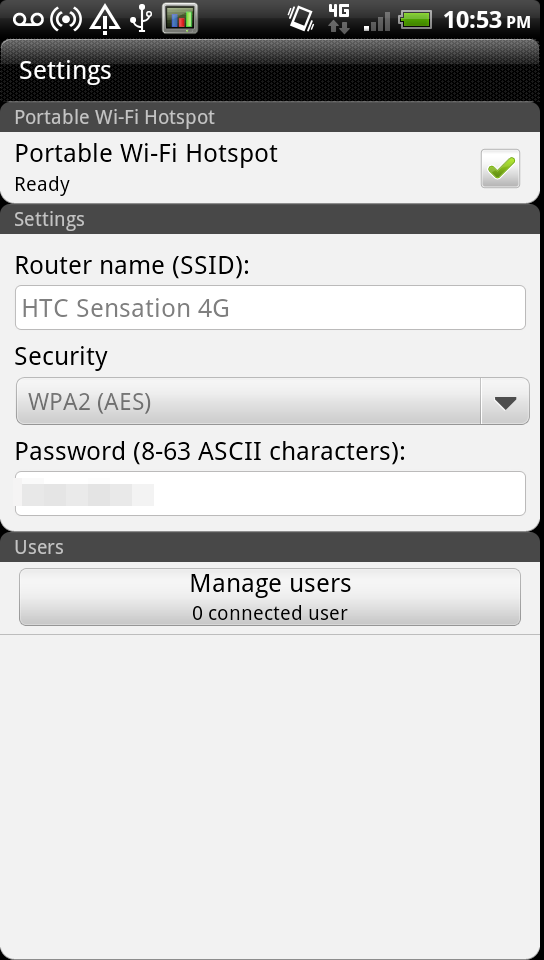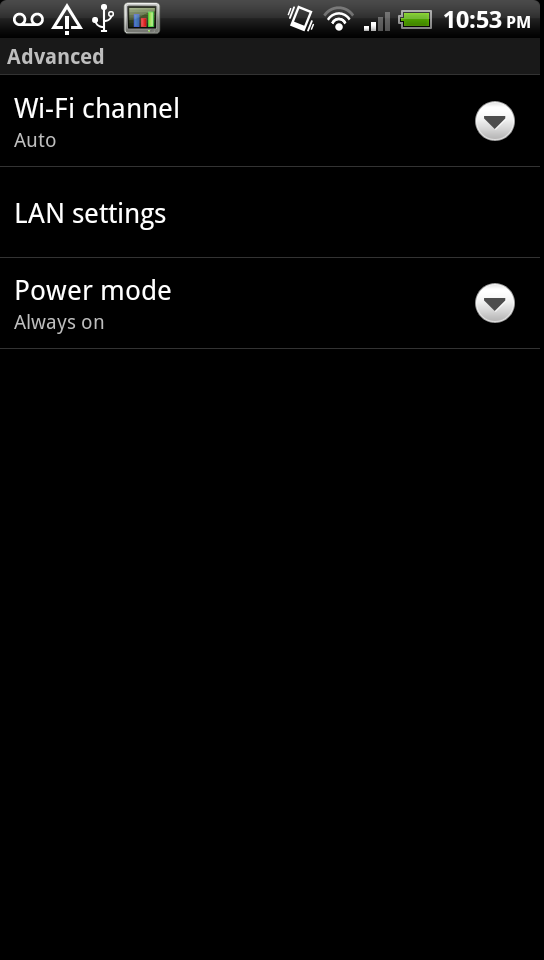HTC Sensation 4G Review - A Sensational Smartphone
by Brian Klug on July 1, 2011 12:38 AM EST- Posted in
- Smartphones
- HTC
- Android
- Mobile
- HTC Sensation
- MSM8260
WiFi Hotspot
The Sensation includes HTC’s own WiFi hotspot software, and nothing much is changed between it and previous versions. It’s still limited to 5 users maximum, and you can view and manage each one’s connectivity. I don’t remember them being options before, but the Sensation also lets you change the WiFi channel and DHCP server settings in the advanced menu alongside the standard power timeout options. I tested the Sensation’s hotspot capabilities pretty extensively and found that things work out perfectly well. Thankfully there aren’t any bugs to speak of, which is more than I can say for the hotspot software on some other recent smartphones.
Speakerphone
Speakerphone on the Sensation isn’t quite as loud or as high quality as we’d like it to be. To be honest, this is probably the only really glaringly bad part of the whole device. I used the phone for navigation a lot while driving the 400 miles to and from California, and then on a trip or two to Phoenix, and the speakerphone volume just isn’t high enough. Listening to music at maximum, it isn’t adequate. For calls, it’s disappointingly quiet and grainy. I’m not sure what happened here or if something needed to go with the phone for it to fit into this form factor, but clearly the speakerphone took a back seat during testing and design, or there’s something flat out wrong.

There’s a grille on the plastic back of the Sensation, then another metal grille. There is a small rubbery ring around the thing as well, so it isn’t like sound is disappearing into a void between the metal case and the plastic back. It just isn’t loud enough.
Voice Calls and Audio Codec
We’re still trying to create an even better way of characterizing and presenting voice quality for smartphones. Until then we’ve provided a recording of the Sensation calling the local ASOS weathe report station by connecting the headset jack to line in. The Senation’s headset audio quality and earpiece volume also are good. The Sensation, like most modern phones, also has ambient noise cancellation which I tested by calling a friend in a very loud environment. Background noise around me was hard to detect on his end. HTC is no doubt using the Fluence noise cancellation audio chain onboard MSM8260.
I listened to lots of Google Music on the Sensation using my pair of Shure SE535 earphones, and found things overall pretty good. The Sensation uses TI’s very low power TLV320AIC3254 stereo audio codec.
Qualcomm's GPS
Last but not least in this section is GPS performance. The Senation uses Qualcomm’s Gen 8 GPS which supports standalone and assisted (A-GPS) mode. I tested and verified that I get a fix from cold start both with cellular connectivity and without WiFi or cellular connectivity. It works and it works well.

Note that airplane mode is on.
In addition, the GPS on the Sensation locks astoundingly quickly. It’s almost instantaneous, which is especially impressive after using the Droid Charge for weeks before, which often took either a few seconds or a full 30 to get a 3D fix.












107 Comments
View All Comments
Chloiber - Friday, July 1, 2011 - link
It's just a warmer white. On AMOLED displays, the white is very blueish (at least in the tested display in this article. Some like it "colder", some "warmer". And yes: AMOLED still produces way too oversaturated colors. It's like turning contrast way too high on your TV (that's often the setting in the shops). People go "Aaahh, look at those colors!" but in reality it's just horrible.The best way to find out is watching a football game. If the green color of the field burns through your eyes, it's wrong ;)
hechacker1 - Saturday, July 2, 2011 - link
It's only yellow/redish in comparison to a that blueish AMOLED. Given a few minutes with the device (not comparing it side-by-side with another) your eyes will adjust to that white temperature.Technically, the internet color-space is designed to be 6500K. So you should want your screen to match that for color accuracy.
Sunlight is closer to 6500K than 8000K for comparison. Ideally the screen would have the full spectrum of the Sun. In reality we can only get an approximation.
jaydee - Friday, July 1, 2011 - link
Battery life was better web browsing on 4G, than browsing on Wifi? How can that be?!metafor - Friday, July 1, 2011 - link
I thought that curious too. Hopefully it's a software issue that will be fixed in upcoming updates. I'd hate to think that the WiFi radio actually consumes more power than HSPA+.Brian Klug - Friday, July 1, 2011 - link
It's confusing to me as well, and something we're starting to see on a few devices lately. I was very puzzled by the result, ran that test twice and still got the same result.-Brian
Stuka87 - Friday, July 1, 2011 - link
Lucky guy!And great review. HTC has come such a long ways. I definitely consider the Sense UI to be far nicer than that of base Android or other OEM's.
rahvin - Friday, July 1, 2011 - link
I haven't used Sense on Android but I have used it on Windows mobile and liked it. But you should really take a look at some of what Engadget found in regards to what Sense does to battery life. It's quite astounding really, in some phones it caused a 50% drop in battery life.poohbear - Friday, July 1, 2011 - link
When are you guys gonna review the Samsung Galaxy S2?? that's a beast of a phone and the best smartphone on the market today. My Korean friend has it and its insane!!! Cna't wait for it to come to America!yelped - Friday, July 1, 2011 - link
Ok, thanks. Great job on the review!introiboad - Friday, July 1, 2011 - link
I really want to see a review of the Galaxy S 2, given that it uses the Exynos SoC with a brand new GPU from ARM itself. Benchmark results are lacking without it :)